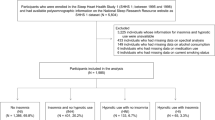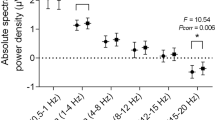Abstract
Purpose
The neuropsychobiological effects of the comorbidity of insomnia and obstructive sleep apnea are not well studied. Our objective was to compare electroencephalographic spectra of patients with comorbid insomnia and sleep apnea syndrome to those of patients with sleep apnea syndrome alone during pre-sleep wakefulness and the N1 and R sleep periods.
Method
We performed electroencephalography and polysomnography on 10 patients with comorbid insomnia and sleep apnea and 10 with only sleep apnea. Electroencephalography spectra analysis was performed for absolute power in clinical bands in six derivations.
Results
Compared to sleep apnea patients, comorbid patients had lower sleep efficiency and total sleep time, higher beta-1 power in the left frontal and central derivations during pre-sleep wakefulness, higher delta power in the left frontal and central derivations during the N1 stage, and higher beta-2 power in the left frontal and central, and right central derivations during the R stage.
Conclusions
Data suggest that patients with insomnia and sleep apnea, compared to patients with only sleep apnea, presented higher left high-frequency rhythms during pre-sleep wakefulness and R sleep stage, and may be for increased emotional and cognitive-related activity, while in stage N1, presented higher left delta power, which suggest some slowing after sleep deprivation.





Similar content being viewed by others
References
American Academy of Sleep Medicine (2013) International classification of sleep disorders, Third edn. Darien, IL
Nofzinger EA, Buysse DJ, Germain A, Price JC, Miewald JM, Kupfer DJ (2004) Functional neuroimaging evidence for hyperarousal in insomnia. Am J Psychiatry 161:2126–2129
Levenson J, Daniel B, Kay D, Buysse D (2015) The pathophysiology of insomnia. Chest 147:1179–1192
Corsi-Cabrera M, Figueredo-Rodriguez P, del Rio-Portilla Y, Sánchez-Romero J, Galán L, Bosch-Bayard J (2012) Enhanced fronto-parietal synchronized activation during wake-sleep transition in patients with primary insomnia. Sleep 35:501–511
Merica H, Blois R, Gaillard JM (1998) Spectral characteristics of sleep EEG in chronic insomnia. Eur J Neurosci 10:1826–1834
Khalidyaouhi F, Bertran F, Clochon P, Mezenger F, Denise P, Foret J, Eustache F, Desgranges B (2009) A combined neuropsychological and brain imaging study of obstructive sleep apnea. J Sleep Res 18:36–48
Ondze B, Espa F, Dauvilliers Y, Billiard M, Besset A (2003) Sleep architecture, slow wave activity and sleep spindles in mild sleep disordered breathing. Clin Neurophysiol 114:867–874
Ong JC, Crawford MR (2013) Insomnia and obstructive sleep apnea. Sleep Med Clin 8:389–398
Bjorvatn B, Pallesen S, Grønli J (2014) Prevalence and correlates of insomnia and excessive sleepiness in adults with obstructive sleep apnea symptoms. Percept Mot Skills 118:571–586
National Institutes of Health. National Institutes of Health State of the Science (2005) Conference statement on manifestations and management of chronic insomnia in adults. Sleep 20:1049–1057
Chung KF (2003) Relationships between insomnia and sleep disordered breathing. Chest 123:310–311
Yang CM, Liao YS, Lin CM, Chou SL, Wang EN (2011) Psychological and behavioral factors in patients with comorbid obstructive sleep apnea and insomnia. J Psychosom Res 70:355–361
Lee M, Lee S-A, Lee G, Ryu H-S, Chung S, Chung Y-S, Kim WS (2014) Gender differences in the effect of comorbid insomnia symptom on depression, anxiety, fatigue, and daytime sleepiness in patients with obstructive sleep apnea. Sleep Breath 18:111–117
Krakow B., Melendrez D, Lee SA, Warner TD, Clark J.O, Sklar D (2004) Refractory insomnia and sleep-disordered breathing: a pilot study. Sleep Breath 8:15–29
Pieh C, Bach M, Popp R, Jara C, Crönlein T, Hajak G, Geisler P (2013) Insomnia symptoms influence in CPAP compliance. Sleep Breath 17:99–104
Philip P, Bioulac S, Altena E, Morin CM, Ghorayeb I, Coste O, Monteyrol PJ, Micoulaud-Franchi JA (2018) Specific insomnia symptoms and self-efficacy explain CPAP compliance in a sample of OSAS patients. PLoS One 13:e0195343
American Academy of Sleep Medicine (2012) The AASM manual for the scoring of sleep and associated events 2012 (2.0). Darien, IL, USA
De Gennaro L, Ferrara M, Bertini M (2001) The boundary between wakefulness and sleep: quantitative electroencephalographic changes during the sleep onset period. Neuroscience 107:1–11
Nuwer MR, Lehman D, Lopes da Silva F, Matsuoka S, Sutherling W, Vibert JF (1994) IFCN guidelines for topographic and frequency analysis of EEG and EPs. Report of an IFCN committee. Electroencephalogr Clin Neurophysiol 91:1–5
Guevara MA, Ramos J, Hernández-González M, Zarabozo D, Corsi-Cabrera M (2003) POTENCOR: a program to calculate power and correlation spectra of EEG signals. Comput Methods Prog Biomed 72:241–250
Brower WS, Black D, Newman TB, Hulley SB (1997) Calculation of the size of the sample and the statistic power. In: Hulley S, Cummings SR (editors.), Clinical research: an epidemiologic approach [in Spanish]. Madrid, Spain: Harcourt Brace. pp. 153-165
Perlis ML, Kher EL, Smith MT, Andrews PJ, Orff H, Gilles DE (2001) Temporal and stagewise distribution of high frequency EEG activity in patients with primary and secondary insomnia and in good sleeper controls. J Sleep Res 1110:93–104
Benetó A, Gómez-Siurana E, Rubio-Sánchez P (2009) Comorbidity between sleep apnea and insomnia. Sleep Med Rev 13(4):287–293
Freedman RR (1986) EEG power spectra in sleep-onset insomnia. Electroencephalogr Clin Neurophysiol 63(5):408–413. https://doi.org/10.1016/0013-4694(86)90122-7
Steriade M (2003) The cortico-thalamic system in sleep. Front Biosci 8:d878–d899
Ray WJ, Cole HW (1985) EEG alpha activity reflects attentional demands, and beta activity reflects emotional and cognitive processes. Science 228:750–752
Acherman P, Finelli LA, Borbély AA (2001) Unihemispheric enhancement of delta power in human frontal sleep EEG by prolonged wakefulness. Brain Res 913:220–223
Acknowledgements
We thank the Posgrado en Ciencias Biológicas UNAM and CONACyT for support to AMPB during her doctoral studies. This article is a requirement to obtain a Doctorate degree in Biological Sciences in the field of knowledge of experimental biology.
Funding
The authors declare that the study has no industry-supported funding.
Author information
Authors and Affiliations
Corresponding author
Ethics declarations
Ethical standards
Our manuscript submitted for possible publication contains a statement that the study has been approved by the appropriate ethics committee and has been performed in accordance with the ethical standards laid out in the Declaration of Helsinki and its later amendments, in the “Methods” section, “Subjects” subsection, last paragraph, page 4.
Conflict of interest
The authors declare that they have no conflicts of interest.
Additional information
Publisher’s note
Springer Nature remains neutral with regard to jurisdictional claims in published maps and institutional affiliations.
Rights and permissions
About this article
Cite this article
Páramo-Brando, A.M., Durán, P., del Río-Portilla, I.Y. et al. Differences in electroencephalographic spectra during pre-sleep wakefulness, N1, and R sleep between comorbid insomnia and obstructive sleep apnea. Sleep Breath 24, 267–275 (2020). https://doi.org/10.1007/s11325-019-01951-y
Received:
Revised:
Accepted:
Published:
Issue Date:
DOI: https://doi.org/10.1007/s11325-019-01951-y




